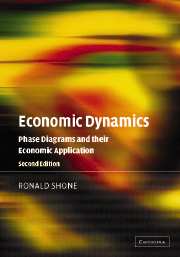Book contents
- Frontmatter
- Contents
- Preface to the second edition
- Preface to the first edition
- PART I Dynamic modelling
- PART II Applied economic dynamics
- 8 Demand and supply models
- 9 Dynamic theory of oligopoly
- 10 Closed economy dynamics
- 11 The dynamics of inflation and unemployment
- 12 Open economy dynamics: sticky price models
- 13 Open economy dynamics: flexible price models
- 14 Population models
- 15 The dynamics of fisheries
- Answers to selected exercises
- Bibliography
- Author index
- Subject index
13 - Open economy dynamics: flexible price models
Published online by Cambridge University Press: 05 June 2012
- Frontmatter
- Contents
- Preface to the second edition
- Preface to the first edition
- PART I Dynamic modelling
- PART II Applied economic dynamics
- 8 Demand and supply models
- 9 Dynamic theory of oligopoly
- 10 Closed economy dynamics
- 11 The dynamics of inflation and unemployment
- 12 Open economy dynamics: sticky price models
- 13 Open economy dynamics: flexible price models
- 14 Population models
- 15 The dynamics of fisheries
- Answers to selected exercises
- Bibliography
- Author index
- Subject index
Summary
Since the advent of generalised floating in 1973 there have been a number of exchange rate models, most of which are dynamic. In this chapter we shall extend our discussion of the open economy to such models. Besides having the characteristic of a flexible exchange rate they also have the essential feature that the price level is also flexible, at least in the long run. This is in marked contrast to chapter 12 in which the price level was fixed. The models are often referred to, therefore, as fix-price models and flex-price models, respectively.
The majority of the flex-price models begin with the model presented by Dornbusch (1976). Although the model emphasised overshooting, what it did do was provide an alternative modelling procedure from the Mundell–Fleming model that had dominated international macroeconomic discourse for many years. It must be stressed, however, that the model and its variants are very monetarist in nature. Although the Mundell–Fleming model assumed prices fixed, which some saw as totally inappropriate, the models in the present chapter assume full employment, and hence a constant level of real income. This too may seem quite inappropriate. Looked at from a modelling perspective, it allows us to concentrate on the relationship between the price level and the exchange rate. Of particular importance, therefore, in such models is purchasing power parity. It does, of course, keep the analysis to just two main variables.
- Type
- Chapter
- Information
- Economic DynamicsPhase Diagrams and their Economic Application, pp. 553 - 592Publisher: Cambridge University PressPrint publication year: 2002



